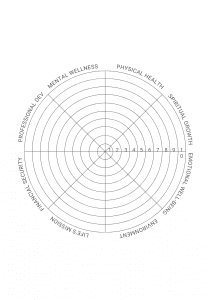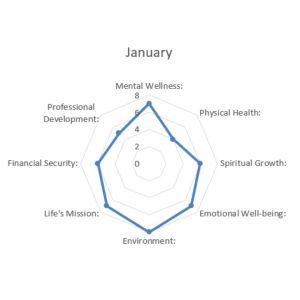Do you use a wheel of life as a part of your monthly where the hell am I, routine? I do. But I confess that I had gotten out of the habit and was persuaded by a feeling of discomfort that led me back. My goal setting and finding that all-important balance was more like a rickety old wheel than something useful.
I have discovered that if I want to do something, I have to make myself and do it because I like the end result.
My year started with the dregs of the lurgy, and I was less than motivated, so I got and assessed myself off my bottom. I also dug out my life goals spreadsheet and updated it – I love a bit of tech to show me what’s happening.
At its core, the Wheel of Life is a visual representation that helps you gauge your satisfaction levels across key life areas. More importantly, it’s about finding balance. Plus for me, it gives me a sense of inner peace.
Why the Wheel of Life is More Than Just a Tool
The true value of the Wheel of Life lies in its ability to provide a “helicopter view” of your life satisfaction in predefined categories. It’s an effective way to identify areas needing improvement, offering instant insights for self-reflection and discussion with a coach or mentor.
How The Wheel Of Life Is Used
When I reviewed what it had given me, the following are just some areas I found supportive. Clients have shared the same. What about you? Does any of this resonate?
- Assessment and Reflection: Rate your level of satisfaction in each life audit area on a scale from 1 to 10. This exercise helps you to identify areas of contentment and areas needing improvement.
- Identifying Imbalances: By visually representing life areas, the Wheel of Life makes it easier to spot imbalances. For example, you may score high in career but low in health and relationships, indicating a potential overemphasis on work at the expense of other life areas.
- Self-Perception: The Wheel of Life can be a reflective tool for emotional intelligence, particularly in understanding your emotions and their interplay with different life aspects. It encourages introspection and emotional self-awareness.
- Focus on Strengths: The Wheel of Life can be used to identify and leverage personal strengths in different life areas.
- Strengths as Solutions: When facing challenges in any area of the Wheel, you can consider how personal strengths can be part of the solution. This approach is empowering and can lead to more creative and effective strategies. Plus, you can identify less well-developed strengths.
- Values: Certain life areas that are neglected or over-emphasised may indicate a misalignment with core values. The Wheel helps rebalance these areas to better reflect what is genuinely important.
- Self-Worth: Often, people judge their worth by a single life aspect, such as career success or relationship status. The Wheel of Life provides a more balanced perspective, showing that self-worth is multi-dimensional and not dependent on just one area.
- Changing Habits: By evaluating these areas, you can pinpoint where negative habits impact your life most and where positive habits could benefit them most.
- Stress Management: By identifying areas of dissatisfaction or imbalance, the Wheel of Life can highlight sources of stress, enabling you to develop targeted strategies for stress management.
- Self-Care: The Wheel of Life encourages a balanced approach to living. It acknowledges that over-focusing on one area (like work) at the expense of others (like health or relationships) can lead to stress and burnout. Self-care is about finding and maintaining this balance.
- Pursuit of Happiness and Fulfillment: The Wheel of Life supports happiness and fulfilment in various life aspects because it focuses on creating balance and harmony.
- Gratitude: Regularly practising gratitude while evaluating the Wheel of Life deepens self-awareness. It highlights what truly matters to an individual and can guide future decisions and goals.
- Inner Peace: Inner peace is not just the absence of stress; it’s also about harmony in various life aspects. The Wheel of Life encompasses different aspects, and balancing these areas contributes to overall well-being and inner peace.
- Goal Setting and Action Planning: The Wheel provides a framework for setting specific, measurable goals. If you score low in a particular area, if you are working with a coach/mentor, then you can work together to set goals and develop a plan of action to improve satisfaction in that area.
- Motivation: When you work towards balance, you are less likely to experience burnout and more likely to maintain motivation across different aspects of your life.
- Monitoring Progress: Over time, you can reassess your Wheel of Life, providing a clear visual representation of how your efforts affect different areas of your life.
- Celebration: Recognising achievements can reignite motivation and enthusiasm for continued personal development. Plus, Celebrating achievements, big or small, enhances self-esteem and self-efficacy.
Advantages Of Using The Wheel Of Life
- Holistic Perspective: It encourages you to consider your whole life, not just one aspect, creating a more balanced approach to personal development.
- Easy to Understand: The visual nature of the Wheel makes it accessible and easy for you to understand and engage with.
- Motivational Tool: It can motivate you to see visual progress as your scores improve in various life areas.
- Facilitates Open Discussion: If you are working with a coach/mentor, it acts as a starting point for deeper conversations about life satisfaction, goals, and personal aspirations.
Categories on the Wheel of Life
The Wheel of Life typically includes 8-10 categories, customisable to reflect personal values and goals. The Wheel of Life areas I’ve created combine various aspects, including mind, body, soul, and spirit. I believe these four aspects are essential for a balanced and fulfilling life, and together, they offer a holistic approach to personal development and well-being.

1. Mental Wellness
Mental wellness is vital as it affects how we think, feel, and act. It influences our ability to handle stress, relate to others, and make choices. Personal growth within this area leads to a better understanding of oneself and an ability to adapt to changes.
2. Physical Health
This area is about respecting and taking care of your body. Good physical health improves the quality of life and reduces the risk of chronic illnesses. You don’t have to run a marathon; you can incorporate regular exercise, balanced nutrition, adequate sleep, and preventive healthcare into your routine.
3. Spiritual Growth
Spiritual growth creates a deeper sense of purpose and connection. It can provide comfort and strength in difficult times and create a sense of community and belonging.
4. Emotional Well-being
Emotional well-being is one of the keys to handling life’s ups and downs. It involves understanding and managing emotions, developing resilience, and building strong, supportive relationships. I consider becoming more emotionally intelligent as a way to nurture your relationship with yourself and others.
5. Environment
Your environment influences your mood, behaviour, and motivation. A positive and supportive environment can significantly enhance your quality of life. Create a living space that reflects your values and needs. Also, consider what relationships do not serve you and how to minimise toxic influences.
6. Life’s Mission
A sense of purpose is linked to better health, happiness, and longevity. It’s about understanding what truly matters to you and pursuing it. Reflect on what brings you meaning and fulfilment and how you can contribute to something larger than yourself.
7. Financial Security
Financial security brings peace of mind. It’s not just about wealth accumulation but understanding how to manage finances effectively for a secure future. Educate yourself on financial strategies, budgeting, saving, and investing. Seek professional advice if necessary, and set realistic financial goals.
8. Professional Development
This area is about personal fulfilment through your career or business. It’s about growth, learning, and finding satisfaction in your professional journey. Pursue opportunities for skill development, set career goals, seek feedback, and stay open to new opportunities and challenges.
At the start of the year, I needed to focus on physical health and professional development. I have my goals, and I’m pleased to say that I am on track.
Questions To Explore Before And After
Here are a few questions for you to ponder…
Before Starting the Wheel of Life Exercise
Understanding Expectations and Mindset
- What are you hoping to gain from this Wheel of Life exercise?
- How do you currently feel about your overall life satisfaction and balance?
- In what areas of your life do you feel most content, and why?
- Are there any specific areas in your life you’re concerned about or feel could be improved?
Exploring Readiness for Change
- On a scale of 1-10, how ready do you feel to make changes in your life?
- What challenges or obstacles have prevented you from making these changes in the past?
- How committed are you to exploring and possibly altering aspects of your lifestyle?
Setting the Groundwork for Self-Reflection
- How do you typically approach self-reflection and self-assessment?
- What does a ‘balanced life’ mean to you?
- Can you think of a time when you felt your life was well-balanced? What did that look like?
After Completing the Wheel of Life Exercise
Initial Reactions and Feelings
- How did you feel while completing the Wheel of Life?
- Were there any surprises or insights that stood out to you?
- Which areas of your life did you score the lowest and highest? What does that say to you?
Understanding the Current State
- For the areas with lower scores, what do you think contributes to these ratings?
- How do these areas impact your overall feeling of life satisfaction and balance?
- In what ways do the higher-scoring areas contribute positively to your life?
Exploring Readiness for Goal Setting
- Which areas are you most motivated to improve?
- What kind of support or resources do you think you’ll need to work on these areas?
- Are there any fears or apprehensions you have about working towards change in these areas?
Prioritising Areas for Development
- If you could choose only one area to improve right now, which would it be and why?
- How do you envision your life changing if improvements are made in this area?
- What small steps could you start taking today to move towards better balance and fulfilment in this area?
Ready, Set Go – Let’s Do A Wheel Of Life
Creating Your Wheel Of Life
Either start by using the Wheel of life provided here or start by drawing a large circle and dividing it into eight equal segments, each representing one of the life areas: Mental Wellness, Physical Health, Spiritual Growth, Emotional Well-being, Environment, Life’s Mission, Financial Security, and Professional Development. Write the name of each life area in its respective segment.
Assessing Each Life Area
Before you begin, get rid of distractions and ground yourself. Without making any quick decisions, look at the Wheel and run through the following assessment areas.
When you have done this, take a few moments to recentre, reground yourself, and then assess yourself. The goal is to make this an honest review so that the work that you do that follows becomes meaningful.
Mental Wellness:
- Reflect on your current state of mental health.
- Consider stress levels, mental clarity, and ability to cope with challenges.
Physical Health:
- Assess your overall physical health and fitness.
- Consider factors such as energy levels, fitness routines, diet, and sleep quality.
Spiritual Growth:
- Evaluate your sense of spiritual fulfilment and growth.
- Consider your connection with your beliefs, values, and practices that give your life meaning.
Emotional Well-being:
- Reflect on your emotional health and stability.
- Consider how well you manage emotions, your sense of happiness, and emotional resilience.
Environment:
- Assess your satisfaction with your physical surroundings.
- Consider your living conditions, work environment, and how these spaces affect you.
Life’s Mission:
- Evaluate how aligned you feel with your life’s purpose or mission.
- Consider whether your daily activities resonate with your deeper goals and aspirations.
Financial Security:
- Assess your feelings of financial stability and security.
- Consider savings, debt, income, and overall financial management.
Professional Development:
- Reflect on your business or career and professional growth.
- Consider business or job satisfaction, career progression, and opportunities for learning and development.
The Wheel Of Life – Rate Yourself
Rate yourself from 1 (it’s a bit rubbish) to 10 (Yahoo, all is well in my world). – What did you learn?
[wheeloflife id=623]
- Mental Wellness
- Physical Health
- Spiritual Growth
- Emotional Well-being
- Environment
- Life’s Mission
- Financial Security
- Professional Development
Reflect on Your Ratings

- Join the dots. Create an inner wheel and reflect on the shape.
- Reflection: Look at your Wheel of Life and notice which areas are flourishing and which need attention and nourishing.
- Identify Imbalances: See if there are areas significantly lower than others. These could be your starting points for improvement.
- Interconnectedness of Areas: Recognise how neglecting one area might impact others. For instance, if ‘Physical Health’ scores low, it might affect your ‘Financial Security’ or ‘Mental Wellness’. You will then see that, in this case, you must address your health to bring the finances back into balance, and this is your priority.
Follow-Up Strategies for Improving Wheel of Life Scores
After identifying areas for improvement using the Wheel of Life, developing strategies for enhancing these scores is your next step. A structured approach can transform insights from the Wheel of Life into actionable steps towards personal growth and satisfaction.
Join a Wheel Of Life Workshop
1. Setting Specific Goals
- For each low-scoring area, set specific, achievable goals. For instance, if ‘Health’ is a low score, a goal might be to exercise three times a week.
- Ensure goals are Specific, Measurable, Achievable, Relevant, and Time-bound. This framework increases the likelihood of success.
2. Developing a Roadmap
- Distinguish between immediate actions and long-term aspirations. Short-term goals act as stepping stones to the bigger picture.
- Set regular intervals (monthly or quarterly) to review and adjust goals as needed. Life circumstances change, and so should your goals.
3. Resources and Support
- For areas like ‘Personal Growth’ or ‘Career’, look for books, courses, or workshops that can provide further development.
- Consider seeking a coach, mentor, or therapist, especially for areas that require expert guidance or counselling.
4. Implementing Habit Changes
- Small daily habits can lead to significant improvements over time. For example, daily meditation can enhance the ‘Personal Growth’ or ‘Health’ segment.
- Consistency is key in habit formation. Utilise habit-tracking apps or journals to maintain progress. I’d also say get to know how you get things done.
5. Reflecting and Journaling
- Regular reflection can provide deeper insights into why certain life areas are lacking.
- Writing down thoughts, feelings, and progress can be therapeutic and clarifying.
6. Accountability Mechanisms
- Share your goals with a trusted friend or family member who can check in on your progress.
- Join groups or forums where members share similar goals for communal support and motivation.
7. Embracing Flexibility and Patience
- Be ready to adapt goals as situations change. Flexibility is crucial in maintaining a balanced approach to life improvement.
- Understand that change takes time. Celebrate small victories, and don’t be too hard on yourself for occasional setbacks.
8. Integrating Mindfulness and Self-Care
- Incorporate mindfulness or meditation into your routine to improve mental health and awareness, which can positively impact all areas of the Wheel.
- Regular self-care activities can boost overall well-being, enhancing satisfaction in various life areas.
9. Seeking Feedback and External Perspectives
- Regularly seek feedback from those you trust. They can offer valuable perspectives on your progress and areas needing attention.
- For career-related goals, consider professional assessments or feedback tools to gauge progress.
10. Experimentation and Exploration
- Don’t be afraid to try new activities or hobbies.
- If one method isn’t working, explore different strategies. Flexibility in approach can lead to better results.
11. Prioritising and Focusing
- Not all life areas need equal attention. Focus on areas that require the most improvement or are most valuable to your personal satisfaction.
- While focusing on lower-scoring areas, ensure that you do not neglect the areas that are already fulfilling.
Join a Wheel Of Life Workshop


